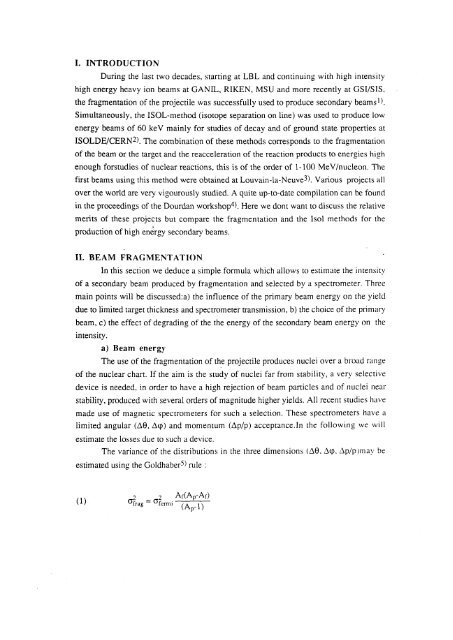Radioactive beams by fragmentation and ISOL techniques - CERN
Radioactive beams by fragmentation and ISOL techniques - CERN
Radioactive beams by fragmentation and ISOL techniques - CERN
You also want an ePaper? Increase the reach of your titles
YUMPU automatically turns print PDFs into web optimized ePapers that Google loves.
intensity.<br />
During the last two decades, starting at LBL <strong>and</strong> continuing with high intensity<br />
high energy heavy ion <strong>beams</strong> at GANH., RIKEN, MSU <strong>and</strong> more recently at GSI/SIS.<br />
the <strong>fragmentation</strong> of the projectile was successfully used to produce secondary <strong>beams</strong>]<br />
Simultaneously, the <strong>ISOL</strong>—method (isotope separation on line) was used to produce low<br />
energy <strong>beams</strong> of 60 keV mainly for studies of decay <strong>and</strong> of ground state properties at<br />
<strong>ISOL</strong>DE/<strong>CERN</strong>2). The combination of these methods corresponds to the <strong>fragmentation</strong><br />
of the beam or the target <strong>and</strong> the reacceleration of the reaction products to energies high<br />
enough forstudies of nuclear reactions, this is of the order of 1-100 MeV/nucleon. The<br />
first <strong>beams</strong> using this method were obtained at Louvain—la-Neuve3). Various projects all<br />
over the world are very vigourously studied. A quite up-to—date compilation can be found<br />
in the proceedings of the Dourdan workshop4). I-Iere we dont want to discuss the relative<br />
merits of these projects but compare the <strong>fragmentation</strong> <strong>and</strong> the Isol methods for the<br />
production of high energy secondary <strong>beams</strong>.<br />
II. BEAM FRAGMENTATION<br />
In this section we deduce a simple formula which allows to estimate the intensity<br />
of a secondary beam produced <strong>by</strong> <strong>fragmentation</strong> <strong>and</strong> selected <strong>by</strong> a spectrometer. Three<br />
main points will be discussedza) the influence of the primary beam energy on the yield<br />
due to limited target thickness <strong>and</strong> spectrometer transmission, b) the choice of the primary<br />
beam, c) the effect of degrading of the the energy of the secondary beam energy on the<br />
a) Beam energy<br />
The use of the <strong>fragmentation</strong> of the projectile produces nuclei over a broad range<br />
of the nuclear chart. If the aim is the study of nuclei far from stability, a very selective<br />
device is needed, in order to have a high rejection of beam particles <strong>and</strong> of nuclei near<br />
stability, produced with several orders of magnitude higher yields. All recent studies have<br />
made use of magnetic spectrometers for such a selection. These spectrometers have a<br />
limited angular (A9, Arp) <strong>and</strong> momentum (Ap/p) acceptance.ln the following we will<br />
estimate the losses due to such a device.<br />
The variance ofthe distributions in the three dimensions (A0. Arp. Ap/phnay be<br />
estimated using the Goldhaberjl rule :<br />
é€f)<br />
Gimg = Ofcrmi -%,%-j OCR Output















